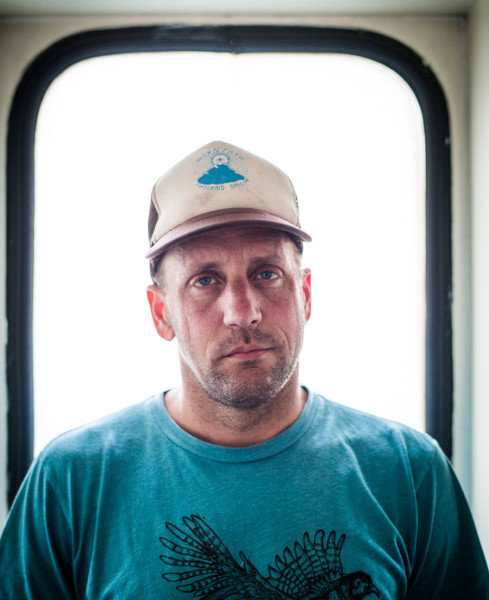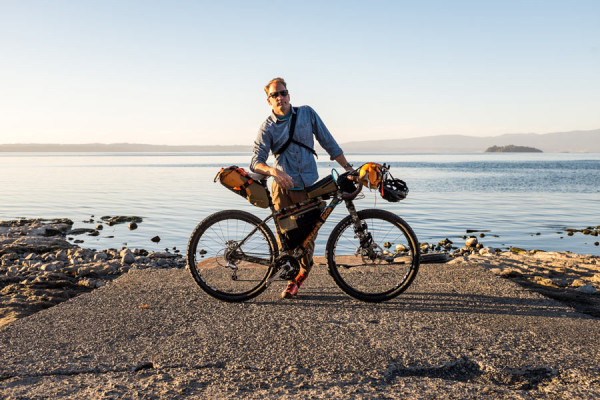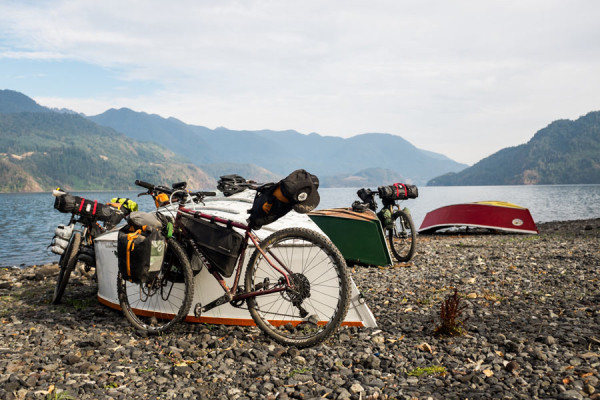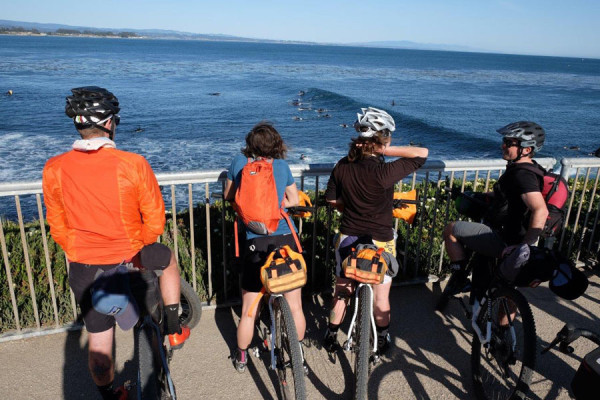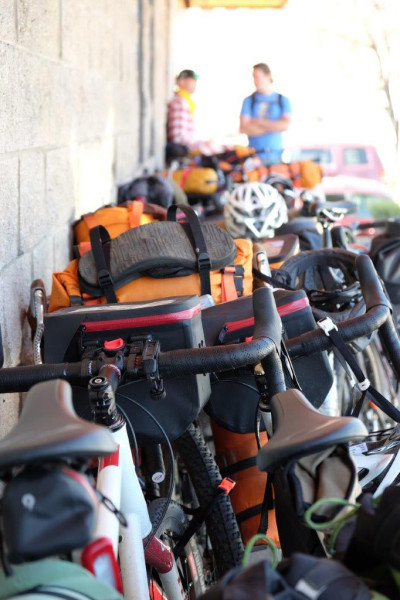Blackburn emerged in a landscape where bicycles were beginning to be recognized in the US for their capabilities as dedicated vehicles of transportation rather than solely recreationally or race purposed. Capitalizing on the opportunity to support the emerging need, Jim Blackburn started the ball rolling to create gear that allowed riders to carry what they needed while getting out there on their own.
The resurgence of the Blackburn brand over the past several years can, at least partially, be linked to its brand manager Robin Sansom. Arriving at Blackburn with a healthy industry pedigree and a soft spot in his heart for cargo bikes and touring, Robin has worked to rectify the current brand with the legacy established by brand founder and spirit animal Jim Blackburn, through the Ranger Program and in product such as the Outpost Bag line.
A few weeks ago, I sat down with Robin in Santa Cruz to discuss the history and the context of the emergence of the brand as well as its current direction.
BIKERUMOR: Where did the brand get its start?
ROBIN: Jim Blackburn graduated from San Jose state 1974ish. I don’t know exactly when that was. Mike Sinyard somehow, as a fledgling business owner, snuck onto Jim’s committee for his graduate studies at San Jose State because Jim was doing this project for a bike as his thesis. Mike was importing all these parts from Italy- that’s why the official name of Specialized is SBC, Specialized Bike Components, because he sold Campagnolo and all these other brands. He’d find these racks from Italy, which I don’t know if you’ve ever used an Italian bicycle rack, they are designed to hold, like, a newspaper. That’s what they carry there.
BIKERUMOR: A cannoli… a newspaper…
ROBIN: They needed racks and nobody makes a rack that can hold more than a newspaper.
BIKERUMOR: That’s a question I have. In the Blackburn literature, there is talk about recognizing opportunity in the “emerging bike culture.” Is this referring to domestic emerging bike culture, or otherwise? Because references to racks at the time, well, there were the Italians. As far as touring racks for road bikes, they also were being made by the Swiss. There were a couple entities, European entities. So is that reference is just to emerging US bike culture?
ROBIN: Absolutely.
BIKERUMOR: I think that’s really important context for Blackburn especially because now people think globally but at that time, it wasn’t really a global situation.
ROBIN: To get something from Europe was fucking impossible. It was an American problem.
BIKERUMOR: I think that’s something worth discussion too.
ROBIN: Basically, the culture was happening. It was happening because- National Geographic at the time was the biggest magazine on the planet. They did a full page spread featuring these two couples that went to South America on their bikes that happened to found the Adventure Cycling Association which now makes all maps for cycling in the US.
BIKERUMOR: Do you know what year that was?
ROBIN: They started in the early 70’s on this ride from Alaska to Argentina. One of the founders of the ACA, he flew to National Geographic and told them what he was going to do. They said he was crazy and they gave him film. That was a big thing back then. Film was really expensive. So they started the trip and sent some back to National Geographic and they said that’s great, we want to do an article. They did the whole trip and they did an article about it. And I think they might have paid them some cash, I’m not sure. But mostly it was film. That captured everyone’s imagination. You think of the time period, you know, people were hitching around in that era and to have a bike… oh shit, I don’t have to hitch anymore. I have a bike. Then they created a Bikecentennial, a celebration of the US Bicentennial, which created a lot of attention. And that’s about the time that Blackburn started making racks, which no one could really get before.
BIKERUMOR: There was this crazy patchwork of small American importers at the time. That was the landscape. I worked for a shop who had been one of these importers. That’s how you would get stuff. You would call or write an importer and get a catalog and then hope they had the shit you wanted. Or ask around, if you were fortunate to have someone knowledgeable on the right stuff to ask… if you even knew what to ask for. QBP and Specialized- people don’t understand why those entities were critical, but at that time you were really otherwise at the mercy of the large bike companies and what they wanted to sell you.
ROBIN: At the time bikes were primarily either toys or for racing. Not for transportation. And I think Jim Blackburn saw that culture emerging. He was like, I’m on it. He was an industrial designer, not a cyclist really. People want this. They don’t know how to get it. I can design it and make it better than anything that’s been available, and I can have it made.
At the time, having stuff made, Silicon Valley was booming with manufacturing. Real manufacturing, not software. Silicon manufacturing was starting but it was real manufacturing. Computers were essentially hard goods at the time. It wasn’t about the software, it was about the hardware. So there were a lot of resources. He capitalized on them. He had the racks made, and the cages made. And pumps and the trainers and so on. He kept recognizing these needs out there and he’s very aware of that.
BIKERUMOR: One thing that can be said about Jim is that he was user focused. Not just making stuff to sell to the user, but being aggressive about addressing actual user needs.
ROBIN: And that takes a certain amount of humility and lack of hubris to be able to do that. It’s not easy, if you’re a designer or engineer there are things you know aren’t technically better, but they are more accepted and people like it. Understand the cultures around it. People want this. Why do they want it? Okay, because they think it’s stiffer. How can we talk to that? To understand that and design around it and say “okay, I can solve that,” it’s pretty fucking cool. I think that guy figured it out. I think that’s our biggest take away for now, for the future. When I talk to Jim Blackburn on the phone, he’s not sentimental. He’s like “I figured out what people wanted and I made it, I made it well, I marketed it well, I’m a good businessman, and I sold my business, and I live on a golf course now and I don’t care what you guys do.”
BIKERUMOR: Why do you talk to him twice a year then?
ROBIN: Because I need to hear that. I think that’s awesome. That’s a great point of view. I did my job. I did it well. I’m doing other things. I have a life. Go away. He doesn’t like the logo, though.
BIKERUMOR: So tell me about the Ranger Program.
ROBIN: I think the best way to relate it is, you know how Jim was super into emerging cultures, we don’t have a mechanism for that these days so much. Our only mechanism is to do it ourselves, the only problem with that is that we have to do our jobs. We have to show up at work every day. We can ride on the weekends, on vacation. We can do marketing trips, but nobody really knows it as well as those people who check out for a couple of months and ride bikes from Mexico to Canada. We thought, well, let’s find those people and make sure we listen to them.
BIKERUMOR: How do you find these people?
ROBIN: There are people where that is their existence like Doom and Steve Fassbinder. We’re not looking for the serial and professional- I mean, we are, we want their feedback as well. We want the people who are counterculture. They are like: you know what, I’m going to quit my job. I’m going to rearrange my identity to ride my bike this amazing distance. It’s not even about the bike. It’s about taking the time off from whatever their lives were and transferring that to a life of travel and adventure. We wanted to really want to tap into that, but we still had a business to run.
It’s easy for us to find the lone guys, but we also wanted to find the people who- it’s funny, the first year we did this, we were just asking people we know, like “do you know anybody who is going to quit their jobs?” At first it was just word of mouth. The second year we did a campaign. A call to action. Are you looking to do this type of riding? This past year we did a more robust version of that, but the same question. People have seen what we’ve done the past couple of years and said hey, that’s something I’d love to be a part of. The Rangers are amazing. We’ve got a great crop. I think we’re in a time and a place where there’s culture out there for this that hasn’t existed in 30-40 years. I don’t know if it is ephemeral, if it will go away.
BIKERUMOR: The thing is that touring has been happening the whole time. But now mainstream industry is starting to support it.
ROBIN: And the demographic has changed too. Young people in the 70’s that rode those bikes kept riding their bikes. They just got older. I think there is a young generation, younger than any of us here, but there is a culture that grew up riding in college, I think that’s the big thing. You go to college and a lot of college towns are a pain in the ass to drive so you bike everywhere. Then you are a bike commuter. Then you are like: now what do I do? Then you are like I can take this cheap vacation and go see these amazing things.
And I think that people’s ambitions are about being happy more than they are about status or money. I think happiness is, especially in this younger generation, a much bigger factor in what they choose in their career path. We’re going for people with great stories, who will give us the best testing.
BIKERUMOR: When you have super experienced people, they have a certain product tolerance and expectations. You get new enthusiasts and they don’t have those expectations. They use it differently. It’s a different intuition.
ROBIN: Like, “where do I put my $2000 camera” or “where is the small pocket to carry my credit cards?” Whereas the experienced people are like “this is where I always put my stuff.”
BIKERUMOR: So the Outpost Bags…
ROBIN: Those things are… I’ve always had this as a product person, like; I made this cargo bike for Kona. It took me three years to get Dan and Jake to let me make this bike. I made the drawings in CAD.
BIKERUMOR: You CAD?
ROBIN: I’m horrible at CAD. It’s like my mom using Paint, that’s kind of like me using CAD. Anyway, I can manage. So I made the bike and put it in the tube for three years and finally I presented and they were like “really? again?” and I was like “yes!” “Go ahead and make it.” And that year it was their best selling bike.
BIKERUMOR: Don’t you love when that happens?
ROBIN: It was like that with the Outpost bags. They were like, aren’t they kind of niche? And I’m like, once people start using these bags like I have, people won’t want racks anymore. They will just want to put those things on. You get the same capacity. Look, I’ve got this bag here. I’ve got a down jacket in there that is warm as fuck. You can throw your sleeping bag and your camera in there. And the same thing is happening with all your camping gear. It’s not like it used to be where all your camping gear was like- your sleeping bag was THIS big around. A beautiful fantastic sleeping bag is only THAT big now. Same thing with tents. Tents used to be huge. So the bags you use on your bikes don’t have to be some fantastic thing attached to a rack. Now they can just attach to the bike. People want the traditional stuff too. So those Outpost Bags that we make are more mountain bike centric… I think will actually become a road staple as well. It works. It’s easy. It’s simple. I can put it on any bike.
What happened in the 70’s and 80’s, when Blackburn racks came along, they were accessible. You could buy them. Before that, you really couldn’t unless you had someone make you one or find the right catalog. That’s what I like about the modern stuff. There are great brands like Relevate and Porcelain Rocket- I love those brands. Just like cargo bikes like the Xtra Cycle, I love that stuff. We’re just trying to make this stuff more accessible. If you live in San Francisco or LA, you can ride from your house to a place where you can to camp in an hour- an hour in a half. If you want a Relevate or Porcelain Rocket bag you have to wait 6-8 weeks and pay a bit more money. I think that’s one thing that Jim Blackburn did with racks that we do with bags.
I mean, that product is awesome. People will buy it, will continue to buy it. But this is product is for everyone else as well. We’re not here to steal market share away from that level of product. All those people that can’t afford the higher level product have something to go to. I think of it as a very democratic way of broadening the market. Getting more people into it. I believe in the democracy- there is a certain economy of scale.
BIKERUMOR: How else do you democratize cycling? How are you proud of that?
ROBIN: I think with all the other accessories it’s been a commodity game. They come into a shop and say “I need a light because it’s dark” or “I got a ticket” or “I don’t feel safe out there.” There aren’t many light brands that have a point of view on that, alright. Some brands have a point of view of like “we’re design.” Our brand has a nice history and point of view on being durable and dependable. All our products can survive these amazing journeys- surely they will be reliable on our ride across town. We build everything with that mentality. We call it “Mission Critical-” “Mission Critical Gear.” If it doesn’t meet that standard then it’s not really one of our products. Hopefully that message will get to the consumer. From everyday blinky lights to things that you depend on to get you through an overnight bike trip.
BIKERUMOR: Where does “Get Out There” come from?
ROBIN: That one is actually super easy. There was an ad that we dug up and here is Jim Jenson riding, a silhouette of him riding with panniers on. The only phrase on the ad was “Get out there.” When I first started at Blackburn, I was hired as product manager. And they were like “Okay, go make product.” And I was like “Okay, who am I making it for?” I had to figure out who the consumer was. I made my own little brand book- like when you’re a kid, you make little cartoons. But I found that ad and I was like, alright, cool, that’s it. Then they put me in charge of the brand so I pulled that into it.
BIKERUMOR: That’s the technical story at how you arrived at that language. How does that apply to your product, man?
ROBIN: Hey man, I have to ride home right now at night through the sketchiest neighborhood in Santa Cruz. I know that the light is going to get me there. And I know that because people who are getting out there in the middle of nowhere have taken this light to those places and it’s what works for them. So it will work for me. And I’ll be fine.
